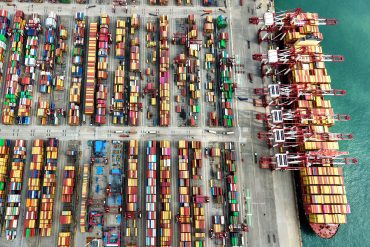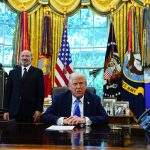
- Rare Earths
- Semiconductors
- Tariffs
Trump’s 100% China Tariff Threat and Shutdown Rewire Trade
5 minute read

Trump’s new 100% tariff threat on China and a third-week shutdown push global supply chains toward a costly reset across chips, EVs and rare earths.
The final quarter of 2025 arrives freighted with consequence. From the Pearl River Delta to Arizona’s desert fabrication plants, factory floors hum with a different frequency now—uncertainty compounding into strategic recalculation. The Trump administration’s escalating confrontation with Beijing, entangled with a protracted domestic fiscal impasse, is reordering the architecture of global supply chains at a velocity that has left even seasoned observers scrambling to map the terrain.
On October 10, President Trump announced via Truth Social an additional 100% tariff on Chinese imports, effective November 1 or sooner should Beijing escalate. Framed as retaliation against what the White House termed “extraordinarily aggressive” Chinese export controls, the levy would stack atop existing duties, driving combined rates on critical goods to 145% or higher. For certain rare earth minerals and specialized components, where retaliatory measures accumulate rather than merely add, the effective burden approaches 245%.
The timing deepens an already precarious moment. That same day, the Office of Management and Budget confirmed that “substantial” reduction-in-force procedures had begun, with notices issued to 4,200 federal employees across seven agencies. The government shutdown, entering its third week after appropriations lapsed September 30, has started extracting operational costs that extend well beyond the familiar theater of furloughed park rangers and darkened monuments. OMB Director Russell Vought positioned the layoffs explicitly as leverage against congressional Democrats—a framing that reveals how thoroughly domestic political warfare has fused with external economic strategy.
Markets absorbed the confluence with sharp alarm. The S&P 500 fell 2.7% on October 10, its steepest single-session decline since April, erasing the week’s gains. Semiconductor stocks led the retreat—Nvidia down 4.2%, Broadcom 3.7%—as investors began pricing not merely higher component costs but potential supply disruptions across categories where alternatives to Chinese processing capacity remain more aspiration than infrastructure.
The Architecture of Escalation
The administration’s tariff framework, built on authorities granted under the International Emergency Economic Powers Act and Section 301 trade provisions, has evolved through successive iterations throughout the year. February brought a baseline 10% surcharge tied to border security concerns. April introduced reciprocal duties of 34%, mirroring Chinese levies on American goods. July brought modifications suspending certain heightened rates until November amid bilateral negotiations, though baseline impositions of 20% on synthetic opioid precursors remained.
The October declaration represents more than quantitative escalation. It marks a qualitative shift toward sectors Washington deems existentially strategic. The $370 billion in affected Chinese goods concentrates heavily in semiconductors, electric vehicle components, and critical minerals—categories where American dependency has long troubled national security planners. The U.S. Geological Survey confirms that China processes approximately 90% of global rare earth output, a dominance Beijing has shown increasing willingness to weaponize.
China’s response has matched this intensity with surgical precision. Ministry of Commerce announcements in April and October expanded export controls on medium and heavy rare earth elements—holmium, erbium, thulium, europium, ytterbium—invoking national security provisions to bar military end-uses. June brought tightened licensing for rare earth derivatives. April controls targeted lithium batteries and graphite anodes, both essential to electric vehicle production, under dual-use prohibitions that stop short of outright bans but achieve similar effect through administrative friction. Beijing, for its part, frames these restrictions as defensive—aimed at preserving national security and industrial stability amid what it views as U.S. technological containment.
These measures recall the 2018-2019 trade confrontation yet exceed it in sectoral specificity and retaliatory coordination. The U.S. Trade Representative’s four-year Section 301 review, completed in May 2024 and guiding current actions, justified duties on the $370 billion import basket through documented intellectual property theft and industrial subsidy programs. Proposed 50% baseline rates for electric vehicles and semiconductors signal that Washington views these sectors less as negotiating leverage than as permanent battlegrounds requiring structural separation.

Fiscal Constraint as Strategic Variable
The domestic funding lapse introduces a dimension largely absent from previous trade confrontations: simultaneous external pressure and internal resource constraint. The January hiring freeze and February’s Department of Government Efficiency initiative preceded the current shutdown, but their cumulative effect has positioned federal workforce reductions not as emergency response but as deliberate policy expression.
The September 19 restriction on certain H-1B nonimmigrant worker approvals illustrated the administration’s willingness to subordinate efficiency arguments to broader narratives. One technology firm’s authorization for 1,700 such visas, concurrent with 2,400 domestic layoffs, became emblematic of tensions between immigration liberalization and employment protectionism that transcend familiar ideological boundaries.
For active-duty military personnel awaiting October 15 paychecks, the shutdown’s continuation past that threshold would breach the implicit compact between federal service and reliable compensation. That such a scenario remains plausible speaks to how thoroughly fiscal brinkmanship has embedded itself in contemporary American governance.
Economic Transmission Mechanisms
The International Monetary Fund’s October World Economic Outlook warns that sustained escalation could shave 0.5 percentage points from global growth, with U.S. GDP facing a 0.9% contraction under prolonged trade war scenarios. Short term, however, tariffs may deliver marginal gains for domestic producers and near-term relief for politically sensitive sectors such as steel, auto parts, and defense equipment—effects that typically fade within two to three quarters, according to IMF elasticity models.
Consumer technology markets face acute passthrough mechanics. The Consumer Technology Association projects the 100% tariff regime would drive average price increases of 31% for smartphones, 32% for monitors, 34% for laptops and tablets, 69% for video game consoles. The organization estimates such increases would erode between $100 billion and $123 billion in annual American purchasing power for electronics—a tax imposed not through legislative debate but executive decree.
IDC projects global information technology spending growth, forecast at 9% for 2025 in pre-escalation models, could halve to 4.5% under prolonged confrontation. Hardware and cloud infrastructure would bear disproportionate impact, with negative GDP effects persisting through 2027 even if tensions ease.
Corporate Reconfiguration
Strategic responses among technology leaders reflect both the immediacy of tariff threats and longer assessments of geopolitical trajectory. Apple’s expanded $600 billion domestic investment commitment, announced in August, encompasses TSMC’s Arizona fabrication facilities projected to yield 19 billion chips for Apple products during 2025. Taiwan Semiconductor Manufacturing Company’s March pledge of $165 billion across three new American facilities and advanced packaging operations represents the largest foreign direct investment in U.S. semiconductor manufacturing history.
Such capital reallocation offers partial insulation from tariff exposure while positioning recipients favorably for Section 301 carve-outs the Trade Representative has signaled for domestic production. Yet execution timelines measured in years collide with tariff schedules measured in weeks, leaving near-term margins exposed regardless of strategic hedging.
Diversification beyond China has accelerated in parallel. Vietnam, India, and Mexico collectively captured an 11.3% increase in U.S. technology imports during the second quarter, per Trade Representative data. Whether these alternative sourcing arrangements prove durable or merely represent temporary arbitrage depends substantially on how those governments navigate their own relationships with Beijing and Washington.

The Uncertain Threshold
As the Asia-Pacific Economic Cooperation summit approaches—slated for October 31-November 1 in Gyeongju, South Korea—the contours of potential diplomatic resolution remain obscure. Washington’s willingness to deploy 100% tariffs—historically reserved for adversarial regimes rather than major trading partners—suggests negotiating posture has hardened beyond conventional face-saving formulas. Beijing’s rare earth controls, calibrated to maximize American vulnerability in defense and technology applications, signal similar determination to exact costs for perceived overreach.
The two economies collectively generate approximately 40% of global GDP. Sustained confrontation at current intensity implies not sectoral adjustment but systemic reconfiguration, with consequences extending beyond trade balances to alliance structures, currency regimes, and technology standards that have underpinned post-Cold War globalization.
For policymakers, the challenge lies in wielding tariffs as negotiating leverage without letting them harden into permanent barriers that impose ongoing efficiency losses. For corporate strategists, resilience increasingly demands geographic redundancy and vertical integration that undo decades of supply chain optimization built around cost minimization. For citizens—whether as consumers facing higher prices or workers displaced by automation investments those higher costs incentivize—the adjustment costs accumulate with compound interest that political rhetoric rarely acknowledges.
Both economies, despite the rhetoric of decoupling, remain bound by deep interdependence in materials, data flows, and consumer demand—an entanglement that neither tariffs nor shutdowns can easily unwind. In this reconfiguration, where silicon meets statecraft and fiscal constraint collides with foreign policy, the innovations deferred may ultimately exact greater costs than current ledgers capture.







